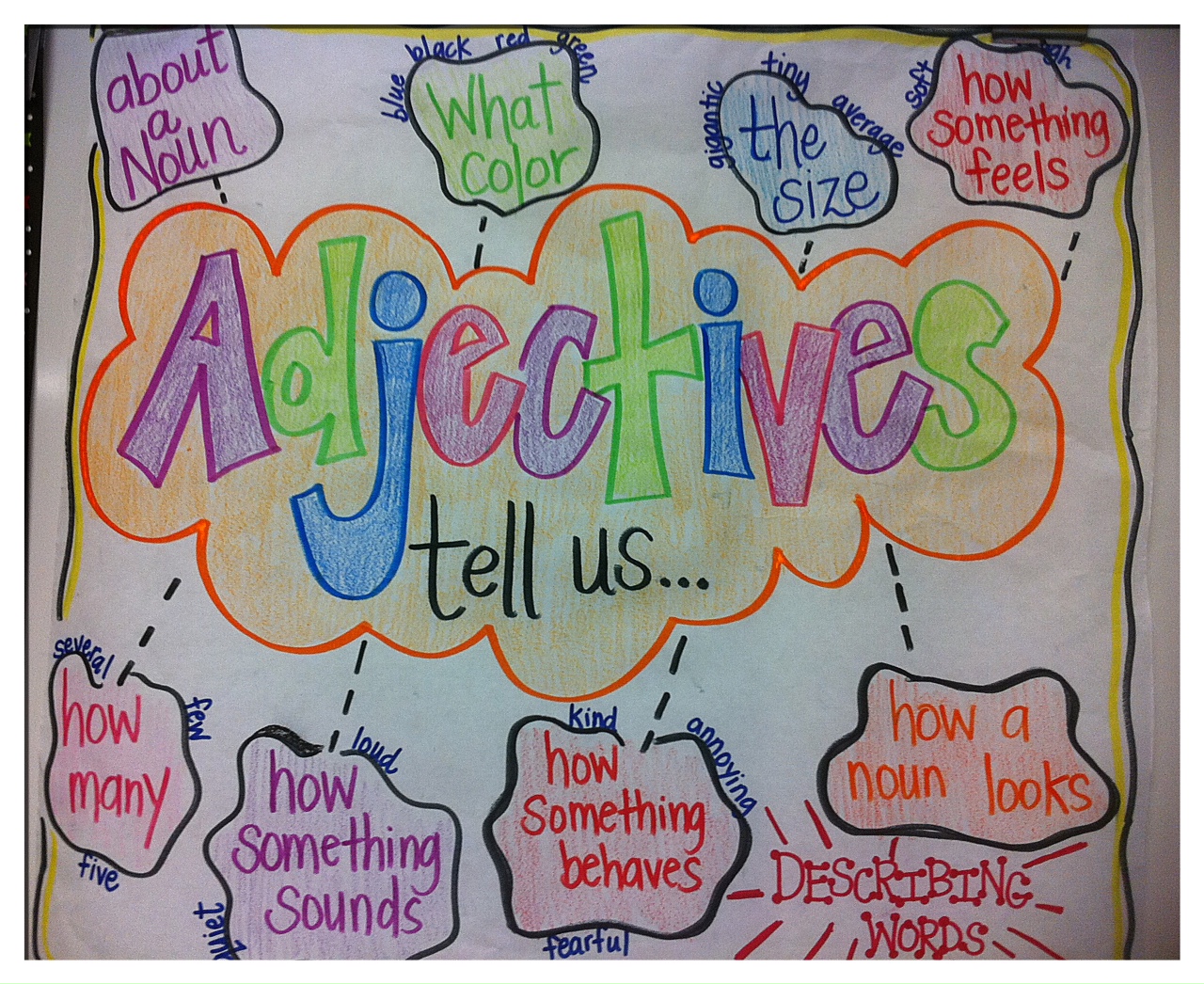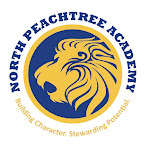4th & 5th Grade Language Test- Wednesday
4th & 5th Grade Math Test- Wednesday
February 26, 2013
Adjectives Review 1
Adjective Study Guide
 |
| Source: http://mrswarnerarlington.weebly.com/ uploads/6/9/0/0/6900648/adjectives3.jpg |
- An adjective is a word that describes a noun or pronoun.
- Adjectives tell whose, how much, what kind or how many.
- Encyclopedias have accurate information. (what kind)
- A library has several dictionaries. (how many)
- Articles--a, an, the
- Articles are special kinds of adjectives. Use a and an to refer to any one item in a group.
- A is used before words beginning with a consonant sound.
- An is used before words beginning with a vowel sound.
- Use the to refer to a particular item or items.
- Demonstrative Adjectives--this, that, these, those
- A demonstrative adjective comes before a noun.
- Demonstrative adjectives tell which one or which ones.
- This and these are used to point out nearby people or things.
- That and those are used to point out people or things far away.
- This and that (singular)
- These and those (plural)
- A proper adjective is formed from a proper noun.
- A proper noun names a certain person, place, thing, or idea.
- A proper adjective begins with a capital letter. (Japanese, African, Hawaiian).
- Comparative adjectives compare two nouns or pronouns.
- Add er to most adjectives or add the word more before longer adjectives.
- Superlative adjectives compare three or more nouns.
- Add est to most adjectives or add the word most before longer adjectives.
- Forms of good and bad:
- good, better, best
- bad, worse, worst
- _________________________________________________________________-
4th Grade Language
Noun – names a person, place, or thingStudy Guide – Adjectives/ Review
Verb – shows action, or state of being
Pronoun – takes the place of a noun
Adjective – describes nouns or pronouns
- answers: Which one? What kind? How many? How much? Whose?
- a, an, and the are always adjectives – they are called articles
Writing Comparisons – adding –er or -est
- if the adjective ends with a short vowel sound before the final consonant, then double the final consonant before adding –er or –est
- if the adjective ends in e, drop the final e before adding –er or -est
- whenever you use –er or –est, make sure you state what you are comparing
Information below is NOT on the next test on 2/27.Adverb – describes verbs, adjectives, and adverbs
- answers: Where? When? How often? To what extent? How?
- often ends in –ly
Example: The bird flew in her cage.
Object of the preposition – the noun after the preposition
Example: The bird flew in her cage.
Conjunction- joins words or groups of words
- common conjunctions include: and, but, or, nor, yet, for
Example: Ouch! That bee stung me!
My, look how well you did!
5th Grade Decimals Review Notes
Decimal Notes Math Notes
for 5th Grade
Reading Decimals
·
“A
decimal point separates the whole number from the places that are less than
one.
·
Place
values extend infinitely in two directions from a decimal point.
·
A
number containing a decimal point is called a decimal number or simply
a decimal.”
|
Hundreds
|
Tens
|
Ones
|
Decimal Point
|
Tenths
|
Hundredths
|
Thousandths
|
|
8
|
4
|
1
|
.
|
5
|
6
|
2
|
Reading a number into the decimals
1. Say the first part (left of the
decimal) of the number like normal. (if
there is one)
2. Say “and” where the decimal is.
3. Say the second part of the number
like normal but end with the last/smallest place value
Example: eight hundred forty one AND five
hundred sixty two thousandths
Practice:
1. 485.856 -
2. 1835.21 –
3. 881.584 –
4. 684.9 –
5. 38.358 –
Decimal Notes Math
Writing Decimals
Writing
Decimals can be written in standard, written, or expanded forms.
Standard -
# form
·
0.2
·
0.85
·
2.376
·
315.007
Written =
word form
·
Two
tenths
·
Eighty-five
hundredths
·
Two
and three hundred seventy-six
thousandths
·
Three
hundred fifteen and seven
thousandths
Expanded =
equation form broken up by place values.
·
(0
x 1) + (2 X .1)
·
(0
x 1) + (8 x .1) + (5 x .01)
·
(2
x 1) + (3 x .1) + (7 x .01) + (6 x .001)
·
(3
x 100) + (1x 10) + (5 x 1) + (0 x .1) + (0 x .01) + (7 x .001)
Rounding Decimals Math
Rounding
decimals is the same as rounding any other whole number.
1. Look to where you are being asked to
round.
2. Then look to the number on the
right.
a. 5 or higher round up
b. 4 or less leave it alone & drop
all the digits to the right of the rounded place value
3. Say your number stopping at the
rounded place value.
Example/Practice:
1. Round 0.876 to the nearest hundredths = .88
2.
Round 1.23 to the nearest tenths =
3.
Round 32.056 to the nearest hundredths =
4.
Round 157.098 to the nearest tenths =
5.
Round 5.752 to the nearest hundredths =
Comparing Decimals
Notes Math
> - greater than
<
- less than
= -
equal to
Comparing decimals is similar to
comparing whole numbers.
Look at the highest place value
available and figure out which number is larger.
Examples:
·
0.86 ___ .65
greater than or >
·
1.038 ___ .0038
·
3.248 ___ 3.258
·
7.2 ___ 7.9
·
5.24 ___ 5.34
·
6.07 ___ 6.7
Week of February 25th Reminders
Dear Students,
The study guides and any helpful resources that I have for this week will be posted here this afternoon for you. Give me just a little bit of time please. Remember to check back soon to see what I have posted for you.
Sincerely,
Miss M
missarynmcelroy@gmail.com
The study guides and any helpful resources that I have for this week will be posted here this afternoon for you. Give me just a little bit of time please. Remember to check back soon to see what I have posted for you.
Sincerely,
Miss M
missarynmcelroy@gmail.com
February 20, 2013
History Study Guide
4th Grade History
Study Guide – Chapter 10
People
Crispus Attucks – a black patriot killed at the Boston Massacre
Ethan Allen – the man who with the help of the Green Mountain Boys captured Fort Ticonderoga
George Rogers Clark – secured the Northwest Territory for America
General Cornwallis – leader of the British army who surrendered to George Washington at the end of the war
George III – King of England during the time of the American War for Independence
Nathan Hale – brave American spy who was killed by the British, he is famous for the words, "I only regret that I have but one life to lose for my country"
John Hancock – the president of the Continental Congress and the first to sign the Declaration of Independence
Patrick Henry – stirred colonists into fighting for freedom from England with these words, "Give me liberty or give me death"
John Paul Jones – Scottish man who helped start the American navy, he is famous for the words, "I have not yet begun to fight"
Paul Revere and William Dawes – rode through towns warning people with these words,
"The British are coming!"
- Paul Revere was also a famous silversmith
George Washington – supreme commander of the American troops, famous for these words, "We have…to resolve to conquer or die"
Hessians – German soldiers hired by George III to fight the Americans
Minutemen – men prepared to fight at a minute’s notice
British soldiers nicknames – "lobster-backs" and "redcoats"
Patriots – American colonists who wanted independence from England
Tories – American colonists who remained loyal to the king of England
Facts to know
Boston Tea Party – after British taxes had been removed except the tax on tea, fifty colonists dressed like Indians and threw the tea into the Boston Harbor to show the king their anger at his taxes
Boston Massacre – a fight between angry colonists and British soldiers where five colonists were killed
Declaration of Independence – a paper signed on July 4, 1776, and sent to the king of England to let him know the colonists wanted to be a free country, no longer under his control
Stamp Act – a law stating that all colonists must pay a tax by buying a seal or stamp to put on all newspapers, marriage certificates, and other documents
Geography
Bunker Hill – where Americans proved they would be hard to beat, they dug trenches for protection
Saratoga – place known as the turning point of the war, this battle showed that the Americans could win
Trenton – place the Hessians were defeated on Christmas
Valley Forge – place where the Continental Army spent a hard winter (1777 – 1778)
Yorktown – place where the British surrendered to the Americans
Bay – a part of a body of water that reaches into the land, usually with a wide opening
Channel – a deep, narrow body of water connecting two larger bodies of water
Delta – land deposited at the mouth of a river
Gulf – a part of an ocean that reaches into the land, generally with a narrower opening than a bay
Lake – an inland body of water that is usually fresh
Plain – flat or level area of land
River – natural stream of water emptying into an ocean, lake, or another river
Source – where a river begins
Valley – a lowland between hills or mountains
Subscribe to:
Posts (Atom)




